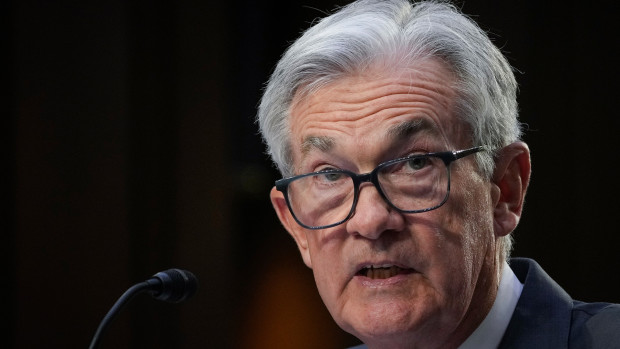
Federal Reserve Chairman Jerome Powell might be ready to unveil a big change in the interest rate narrative when he speaks at the central bank's annual summit in Jackson Hole on Friday. It's just not likely to be the kind of shift markets are looking for.
Powell, quietly basking in the success of the Fed's 18-month inflation fight, will remind investors that headline CPI has fallen by nearly two-thirds since it peaked at 9.1% in summer 2022, while unemployment has largely remained at or near the lowest levels in five decades.
It's an extraordinary achievement -- on both sides of the central bank's twin mandate of price stability and full employment -- for any Fed chairman, let alone one who has faced the intense criticism Powell had to endure following his "transitory" gaffe in April 2021.
But Powell isn't likely to unfurl anything close to a "mission accomplished" banner when he addresses the Fed's annual central bank symposium in the northwestern Wyoming resort, largely, and paradoxically, because of the success of his efforts.
The economy, according to Atlanta Fed estimates, is surging at a 5.8% clip this quarter, more than twice the pace of growth recorded over the three months ended in June; weekly applications for jobless benefits are holding steady, and recession bets, which dominated the financial market conversation earlier this year, have largely disappeared.
Labor markets remain tight
New applications for jobless benefits fell by 10,000, to 230,000 last week, reflecting the tight conditions in an already inflationary labor market.
The BLS reported last month that average hourly earnings rose 4.4% from a year earlier, and 0.3% from June, even as the overall tally of new jobs created slowed to 187,000, the lowest since December 2020.
Delivery giant UPS (UPS) -) last month reached a labor agreement with the Teamsters Union. That pact, ratified this week, will pay workers $21 per hour -- a 31.25% increase -- and more experienced drivers as much as $50 per hour.
The United Autoworkers' Union, meanwhile, is demanding a 40% increase for its members as it starts negotiations with Ford (F) -), General Motors (GM) -) and Stellantis (STLA) -) on a contract that was last agreed in 2019.
"The Fed has been waiting for their rate cuts to loosen up a tight jobs market, but employers have continued to hold on to their workers," said Mike Loewengart, head of model portfolio construction at Morgan Stanley Global Investment Office.
"With weekly jobless claims again coming in lighter than expected, the Fed will have to wait and see if next week’s monthly jobs report shows the data moving in the other direction," he added. "In the meantime, the question remains: Can the Fed engineer a soft economic landing without some softening in the labor market?"
Pockets of weakness are starting to emerge, however, with manufacturing and services activity over the month of August in retreat and retailers from Target and Walmart to Foot Locker and Dick's warning that consumer spending is set for an autumn slowdown.
Once again, however, the timing of that weakness may work to Powell's advantage: Bond markets might not be predicting recession, but they aren't forecasting runaway growth either. And recent moves in longer-dated Treasurys suggest the biggest issue Powell faces isn't about rate hikes or rate cuts, but for how long he's willing to keep the current federal-funds rate in place.
Bond markets see growth, not inflation
Benchmark 10-year Treasury note yields, which are more often influenced by growth prospects than Fed rate prospects, have risen by around 30 basis points (0.3 percentage point) this month -- meaning prices have fallen substantially -- as investors move cash into other pockets of the financial market matrix.
At the same time, however, 2-year Treasury yields have held steady and have traded just under the 5% mark, suggesting only a modest prospect of a big change in the Fed's rate path.
Bets on a 2024 rate cut, in fact, have fallen sharply over the past month, with traders only pricing in 100 basis points, or 1 percentage point, of reductions over the whole of next year, according to data from CME Group's FedWatch.
The chances of another rate hike between now and the end of the year, made during one of the Fed's final three meetings, is no better than 42% (pegged for the policy decision on Nov. 1).
The more likely narrative, which is being tested by Fed officials such as Boston Fed President Susan Collins, is that rates are likely to remain at these elevated levels -- at least until the economy can no longer bear the tension -- for a sustained period.
“I do think it’s extremely likely that we will need to hold for a substantial amount of time, but exactly where the peak is I would not signal right at this point,” Collins told Yahoo Finance on Thursday. “We may be near but we made we may need to increase a little bit further”.
That may be where Powell ultimately lands as well, as he and his dovish colleagues -- citing the fact that past rate hikes have yet to work their way through the broader economy -- clash with hawks, who point to labor-market tightness, rising wages and stubbornly sticky personal-consumption-expenditure inflation rates.
"We’ve raised the federal-funds rate now by 525 basis points [5.25 percentage points] since March 2022," Powell told reporters last month in Washington. "Monetary policy, we believe, is restrictive and is putting downward pressure on economic activity and inflation."
That hasn't been the case for the former, of course, but it's certainly been true of the latter.
Behold the ghost of Paul Volcker
The question for Powell, heading into tomorrow's speech at 10:05 am Eastern Time, is whether he's willing to add more weight (in the form of rate hikes) on the economy to achieve his inflation target, or wait and allow for the full effect of the tightening already put in place.
The legendary former Fed Chairman Paul Volcker, credited with crushing a devastating wage-inflation spiral with relentless rate hikes in the early 1980s, had to effectively break the nation's labor market in order to succeed.
Powell has proved far more nuanced.
"The political backdrop has shifted exponentially, and maintaining strength in the labor market has become increasingly important," said Quincy Krosby, chief global strategist for LPL Financial in Charlotte.
"The doves on the [Federal Open Market Committee] are aligned in acknowledging that while inflation remains elevated, the Fed should remain on hold to help keep the labor market intact and allow the cumulative rate hikes to unfold into the broader economy," she added. "For the hawks, it's ensuring that inflation expectations remain anchored, thus most likely requiring another rate hike."
"We know what Volcker would say, and Powell may wholeheartedly agree, but times have changed," Krosby said.
- Receive full access to real-time market analysis along with stock, commodities, and options trading recommendations. Sign up for Real Money Pro now.







